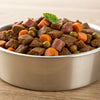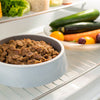Is Wet Food Better for Dogs Than Dry? Understanding the Best Options for Your Canine Companion
- Houndsy
Table of Contents
- Introduction
- Understanding Wet and Dry Dog Food
- Benefits of Wet Dog Food
- Drawbacks of Wet Dog Food
- Benefits of Dry Dog Food
- Drawbacks of Dry Dog Food
- The Best of Both Worlds: Mixing Wet and Dry Dog Food
- How Houndsy Elevates Your Feeding Experience
- Conclusion
Introduction
As pet owners, we often find ourselves pondering the seemingly simple question: is wet food better for dogs than dry? Did you know that over 70% of dog owners have considered transitioning their pets between different diets? With the plethora of dietary options available on the market today, pet parents are constantly in search of the best sustenance for their four-legged friends. Choosing between wet and dry dog food is a fundamental decision that affects not just your dog's health but also their eating experience and, ultimately, your convenience as a pet owner.
The purpose of this blog post is to explore the intricacies of wet and dry dog food, hoping to shed light on which option might best fit your pet’s needs and lifestyle. By the end of this comprehensive guide, you’ll not only understand the benefits and drawbacks of each food type but also learn how Houndsy can enhance your dog feeding experience. After all, providing the right nutrition is just as crucial as ensuring mealtime is a pleasant ritual for both you and your furry companions.
We will cover the key differences between wet and dry dog food, the nutritional implications, and how personal circumstances—like your dog's health and preferences—factor into the decision. Along the way, we’ll also introduce our flagship product, the Houndsy Kibble Dispenser, designed to elevate your dog feeding experience.
Let’s dive deeper into the age-old debate: is wet food better for dogs than dry?
Understanding Wet and Dry Dog Food
What Is Wet Dog Food?
Wet dog food, often found in cans or pouches, contains a high moisture content—up to 84%! This moisture makes it more palatable for many dogs, particularly picky eaters. The typical processing of wet dog food involves grinding protein sources, adding vitamins and minerals, mixing in a gravy-like substance, and cooking it to create a safe and edible product. The appeal of the strong aromas and flavors makes wet food an enticing option for dogs, especially those with reduced appetites due to health conditions or age.
What Is Dry Dog Food?
Dry dog food, or kibble, contains significantly less moisture—around 5-10%. The production process involves extruding a dough-like mixture of meat and grains, which is then cooked and dried. This results in a product that is not only easier to store but also less messy during feeding. Dry kibble can be scooped into bowls quickly and has a long shelf life, making it a convenient choice for many pet owners.
Nutritional Composition: Comparing Wet and Dry Food
Both wet and dry foods can provide balanced nutrition, but the nutritional profiles of the two can vary considerably.
- Protein: Wet foods often contain higher protein levels, typically at around 8-25%, while dry foods range from 18-30%.
- Carbohydrates: Dry dog food tends to contain more carbohydrates, which are necessary for the cooking process. In contrast, wet foods usually have lower carbohydrate content.
- Fat: The fat content in wet dog food can be higher, which is beneficial for energy but may be unsuitable for dogs with specific health issues like pancreatitis.
Common Misconceptions
Many pet owners mistakenly believe that one type of dog food is overall superior to the other. However, both wet and dry foods have their specific advantages, and the decision should be based on multiple factors unique to your dog.
Benefits of Wet Dog Food
1. Higher Moisture Content
As we've noted, wet dog food has much higher moisture levels, making it an excellent choice for dogs that may not drink enough water. This hydration can be particularly crucial for those with urinary or kidney concerns.
2. Palatability
The strong aroma and rich flavor profiles of wet food tend to entice even the fussiest eaters. This is especially beneficial for dogs who might be recovering from illness and need some encouragement to eat.
3. Easier to Chew
For dogs with dental issues, wet food can be significantly easier to consume since it's soft and doesn’t require extensive chewing. This makes it a suitable choice for senior dogs or those with dental problems.
4. Satiety
Wet food can promote a sense of fullness, which can be beneficial for weight management. The hydration and texture can help dogs feel satisfied without increasing caloric intake excessively.
Drawbacks of Wet Dog Food
1. Messier
While dogs typically enjoy mess-free eating, wet food can be quite messy for pet owners to clean up. It can create a watery feeding area and often sticks to bowls and dog fur.
2. Shorter Shelf Life
Once a can or pouch is opened, wet food must be consumed quickly to prevent spoilage, making it less convenient for dogs that eat slowly or graze.
3. Generally More Expensive
Wet food is often pricier than dry kibble, especially when feeding multiple dogs or larger breeds.
Benefits of Dry Dog Food
1. Convenience
Dry dog food is simpler and more convenient to store, measure, and serve. It’s easier to scoop and doesn’t require refrigeration.
2. Dental Health Benefits
The texture of dry kibble can aid in cleaning your dog's teeth as they chew, helping to reduce tartar buildup and supporting overall dental health.
3. Cost-Effectiveness
Dry food typically costs less in the long run, making it a more economically feasible choice for many families.
4. Longer Shelf Life
Dry kibble can remain fresh for months if stored properly, minimizing waste and allowing you to buy in bulk.
Drawbacks of Dry Dog Food
1. Less Palatable
Dry food might not be as tempting for picky eaters. Lower moisture content means that it lacks the strong aromas that many dogs find appealing.
2. Possible Carbohydrate Overload
While carbohydrates are necessary, an excessive amount can lead to weight gain and other health issues.
3. Less Hydration
For dogs that are already dehydrated or don’t drink enough, dry food isn’t the best option as it doesn’t provide any moisture to help with hydration.
The Best of Both Worlds: Mixing Wet and Dry Dog Food
One of the most flexible options for pet owners is to mix wet and dry dog food. This allows you to tailor your dog’s diet based on their specific preferences and health needs, all while reaping the benefits of both types of food. For example, mixing a small amount of wet food with dry kibble can enhance the flavor without excessive calorie intake. It’s essential to ensure that this mix still meets your dog’s caloric needs—perhaps even consulting with your veterinarian to achieve a proper balance.
How Houndsy Elevates Your Feeding Experience
Regardless of whether you opt for wet or dry food, we at Houndsy believe the feeding experience should be as enjoyable and stress-free as possible. Our flagship product, the Houndsy Kibble Dispenser, is designed to simplify mealtime. With features like perfect portion control, an elegant mid-century modern design, and a convenient crank at standing height, we aim to enhance both your experience and your dog's feeding ritual. No more messy spills or uneven portions—just a clean, reliable way to serve your dog the nutrition they deserve.
Key Features of the Houndsy Kibble Dispenser
- Perfect Portion Control: Multiple settings allow you to dispense exactly the right amount of food, accommodating both wet and dry options.
- Ergonomic Design: Standing height functionality means no more bending over, allowing for a more comfortable feeding session.
- Aesthetically Pleasing: Our modern design fits seamlessly into your home decor while serving as a functional feeding solution.
- Durable Materials: Crafted from high-quality materials, so you can trust reliability and longevity.
Conclusion
In the end, the question of whether wet food is better for dogs than dry comes down to individual needs. Both types of food have unique advantages and disadvantages, making the choice a personal one influenced by your dog's health, preferences, and your lifestyle considerations. As pet owners, we have the responsibility to ensure our dogs receive the nutrition they need while making mealtimes enjoyable.
To truly elevate your pet care experience, consider enriching your feeding routine with the Houndsy Kibble Dispenser. Not only does it streamline the feeding process, but its design enhances your home atmosphere while ensuring your dog gets the perfect portion every time. Let’s make mealtime special together!
FAQ
Is it okay to mix wet and dry dog food?
Yes, mixing wet and dry dog food can provide a well-rounded diet. Just ensure you are adjusting portion sizes to meet your dog’s caloric needs.
Which is better for a senior dog?
Wet food may often be easier for senior dogs to chew and digest due to its soft texture, and it provides added hydration. However, consult your veterinarian for personalized recommendations.
How do I transition my dog to a new food type?
When transitioning your dog to a new diet, do so gradually over a week or more by mixing increasing amounts of the new food with the current diet. Monitor your dog for any gastrointestinal disturbances during this time.
How much should I feed my dog?
Portion sizes can vary widely based on your dog’s size, age, and activity level. Consult with your veterinarian to determine the specific caloric needs of your dog.
Can wet food spoil?
Yes, once opened, wet food can spoil relatively quickly if not stored properly. It's best to refrigerate leftovers and use them within 3-5 days.
By addressing your dietary choices with informed consideration and enhancing the feeding experience with innovative products, we can ensure happier, healthier mealtimes for our beloved canine companions.













